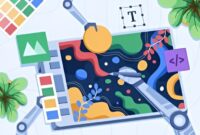The rapid advancements in artificial intelligence (AI) have sparked speculation about its potential impact on various industries, including user experience (UX) design. Some believe that AI will revolutionize UX design, while others question whether it can truly replace human designers. This article explores the current landscape of AI in UX design, examines its capabilities and limitations, and discusses the potential implications for UX professionals.
Current State of AI in UX Design
AI algorithms are increasingly used in UX design tools and platforms. These algorithms can assist with tasks such as:
- Content personalization: AI can analyze user data to tailor website content and recommendations to individual preferences.
- A/B testing: AI-powered A/B testing tools automate the process of testing multiple design variations and identifying the most effective ones.
- User research: AI can help designers gather and process user feedback, providing valuable insights into user needs and behaviors.
- UI prototyping: AI-driven prototyping tools allow designers to quickly create and iterate on design concepts.
Capabilities and Limitations of AI in UX Design
While AI offers significant capabilities in UX design, it also has limitations:
- Creativity and Empathy: AI lacks the inherent creativity and empathy of human designers. It can generate solutions based on past data but struggles to come up with novel or innovative ideas.
- Subjective Interpretation: UX design often involves subjective judgments and interpretations. AI algorithms may not always be able to capture the nuances and context of user experiences.
- Bias and Fairness: AI systems can be biased if trained on data sets that reflect existing societal biases. This can lead to unfair or discriminatory design decisions.
- Need for Human Intervention: AI can assist with many tasks in UX design, but it cannot completely replace human designers. Designers are still required to interpret AI insights, make decisions, and ensure that design solutions meet user needs.
Potential Implications for UX Professionals
The integration of AI in UX design has implications for UX professionals:
- Enhanced Productivity: AI can automate repetitive tasks, freeing up designers to focus on more creative and strategic aspects of their work.
- Improved Data-Driven Decision-Making: AI provides access to vast amounts of user data, which can help designers make informed decisions based on objective metrics.
- Role Evolution: As AI becomes more sophisticated, UX professionals may need to adapt their skills and focus on areas where human input is essential, such as concept generation, user empathy, and ethical considerations.
- Collaboration with AI: UX designers will likely collaborate more closely with AI systems, using them as tools to complement their own expertise.
Conclusion
It is unlikely that AI will completely replace UX designers in the foreseeable future. Instead, AI is expected to enhance and augment UX design practices by automating tasks, providing data-driven insights, and enabling more personalized and efficient user experiences. UX professionals will need to embrace AI as a powerful tool while still leveraging their unique creativity, empathy, and critical thinking skills.
Recommendations for UX Professionals
To stay relevant in the age of AI, UX professionals should:
- Familiarize themselves with AI tools and algorithms.
- Focus on developing skills in creativity, user empathy, and ethical design.
- Collaborate effectively with AI systems and leverage them to enhance their design process.
- Embrace continuous learning and stay up-to-date with technological advancements.
By understanding the capabilities and limitations of AI, UX professionals can harness its power to create more meaningful and effective user experiences while ensuring that human-centric principles remain at the core of UX design.




